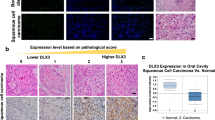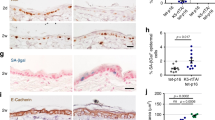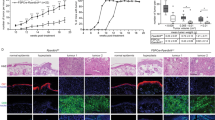Abstract
Cellular movement is controlled by small GTPases, such as RhoA. Although migration is crucial for cancer cell invasion, the specific role of RhoA in tumor formation is unclear. Inducing skin tumors in mice with a keratinocyte-restricted loss of RhoA, we observed increased tumor frequency, growth and invasion. In vitro invasion assays revealed that in the absence of RhoA cell invasiveness is increased in a Rho-associated protein kinase (ROCK) activation and cell contraction-dependent manner. Surprisingly, loss of RhoA causes increased Rho signaling via overcompensation by RhoB because of reduced lysosomal degradation of RhoB in Gamma-aminobutyric acid receptor-associated protein (GABARAP)+ autophagosomes and endosomes. In the absence of RhoA, RhoB relocalized to the plasma membrane and functionally replaced RhoA with respect to invasion, clonogenic growth and survival. Our data demonstrate for the first time that RhoA is a tumor suppressor in 7,12-dimethylbenz[a]anthracene/12-O-tetradecanoylphorbol 13-acetate skin carcinogenesis and identify Rho signaling dependent on RhoA and RhoB as a potent driver of tumor progression.
This is a preview of subscription content, access via your institution
Access options
Subscribe to this journal
Receive 50 print issues and online access
$259.00 per year
only $5.18 per issue
Buy this article
- Purchase on Springer Link
- Instant access to full article PDF
Prices may be subject to local taxes which are calculated during checkout







Similar content being viewed by others
References
Sahai E, Marshall CJ . RHO-GTPases and cancer. Nat Rev Cancer 2002; 2: 133–142.
Pedersen E, Brakebusch C . Rho GTPase function in development: how in vivo models change our view. Exp Cell Res 2012; 318: 1779–1787.
Karlsson R, Pedersen ED, Wang Z, Brakebusch C . Rho GTPase function in tumorigenesis. Biochim Biophys Acta 2009; 1796: 91–98.
Iden S, Collard JG . Crosstalk between small GTPases and polarity proteins in cell polarization. Nat Rev Mol Cell Biol 2008; 9: 846–859.
Wheeler AP, Ridley AJ . Why three Rho proteins? RhoA, RhoB, RhoC, and cell motility. Exp Cell Res 2004; 301: 43–49.
Ridley A . GTPase switch: Ras then Rho and Rac. Nat Cell Biol 2013; 15: 337.
Rath N, Olson MF . Rho-associated kinases in tumorigenesis: re-considering ROCK inhibition for cancer therapy. EMBO Rep 2012; 13: 900–908.
Rodrigues P, Macaya I, Bazzocco S, Mazzolini R, Andretta E, Dopeso H et al. RHOA inactivation enhances Wnt signalling and promotes colorectal cancer. Nat Commun 2014; 5: 5458.
Palomero T, Couronne L, Khiabanian H, Kim MY, Ambesi-Impiombato A, Perez-Garcia A et al. Recurrent mutations in epigenetic regulators, RHOA and FYN kinase in peripheral T cell lymphomas. Nat Genet 2014; 46: 166–170.
Yoo HY, Sung MK, Lee SH, Kim S, Lee H, Park S et al. A recurrent inactivating mutation in RHOA GTPase in angioimmunoblastic T cell lymphoma. Nat Genet 2014; 46: 371–375.
Sakata-Yanagimoto M, Enami T, Yoshida K, Shiraishi Y, Ishii R, Miyake Y et al. Somatic RHOA mutation in angioimmunoblastic T cell lymphoma. Nat Genet 2014; 46: 171–175.
Vallois D, Dobay MP, Morin RD, Lemonnier F, Missiaglia E, Juilland M et al. Activating mutations in genes related to TCR signaling in angioimmunoblastic and other follicular helper T-cell-derived lymphomas. Blood 2016; 128: 1490–1502.
Nagata Y, Kontani K, Enami T, Kataoka K, Ishii R, Totoki Y et al. Variegated RHOA mutations in adult T-cell leukemia/lymphoma. Blood 2016; 127: 596–604.
Kakiuchi M, Nishizawa T, Ueda H, Gotoh K, Tanaka A, Hayashi A et al. Recurrent gain-of-function mutations of RHOA in diffuse-type gastric carcinoma. Nat Genet 2014; 46: 583–587.
Lawrence MS, Stojanov P, Mermel CH, Robinson JT, Garraway LA, Golub TR et al. Discovery and saturation analysis of cancer genes across 21 tumour types. Nature 2014; 505: 495–501.
Vega FM, Colomba A, Reymond N, Thomas M, Ridley AJ . RhoB regulates cell migration through altered focal adhesion dynamics. Open Biol 2012; 2: 120076.
Alfano D, Ragno P, Stoppelli MP, Ridley AJ . RhoB regulates uPAR signalling. J Cell Sci 2012; 125 (Pt 10): 2369–2380.
Vega FM, Ridley AJ . The RhoB small GTPase in physiology and disease. Small GTPases 2016, e-pub ahead of print 22 November 2016 doi:10.1080/21541248.2016.1253528.
Liu AX, Rane N, Liu JP, Prendergast GC . RhoB is dispensable for mouse development, but it modifies susceptibility to tumor formation as well as cell adhesion and growth factor signaling in transformed cells. Mol Cell Biol 2001; 21: 6906–6912.
Vega FM, Fruhwirth G, Ng T, Ridley AJ . RhoA and RhoC have distinct roles in migration and invasion by acting through different targets. J Cell Biol 2011; 193: 655–665.
Jackson B, Peyrollier K, Pedersen E, Basse A, Karlsson R, Wang Z et al. RhoA is dispensable for skin development, but crucial for contraction and directed migration of keratinocytes. Mol Biol Cell 2011; 22: 593–605.
Nassar D, Latil M, Boeckx B, Lambrechts D, Blanpain C . Genomic landscape of carcinogen-induced and genetically induced mouse skin squamous cell carcinoma. Nat Med 2015; 21: 946–954.
Filler RB, Roberts SJ, Girardi M . Cutaneous two-stage chemical carcinogenesis. CSH Protoc 2007; 2007: pdb prot4837; doi:10.1101/pdb.prot4837.
Schober M, Fuchs E . Tumor-initiating stem cells of squamous cell carcinomas and their control by TGF-beta and integrin/focal adhesion kinase (FAK) signaling. Proc Natl Acad Sci USA 2011; 108: 10544–10549.
Wilhelmsen K, Litjens SH, Sonnenberg A . Multiple functions of the integrin alpha6beta4 in epidermal homeostasis and tumorigenesis. Mol Cell Biol 2006; 26: 2877–2886.
Worthylake RA, Burridge K . RhoA and ROCK promote migration by limiting membrane protrusions. J Biol Chem 2003; 278: 13578–13584.
Totsukawa G, Wu Y, Sasaki Y, Hartshorne DJ, Yamakita Y, Yamashiro S et al. Distinct roles of MLCK and ROCK in the regulation of membrane protrusions and focal adhesion dynamics during cell migration of fibroblasts. J Cell Biol 2004; 164: 427–439.
Jennings RT, Strengert M, Hayes P, El-Benna J, Brakebusch C, Kubica M et al. RhoA determines disease progression by controlling neutrophil motility and restricting hyperresponsiveness. Blood 2014; 123: 3635–3645.
Howe GA, Addison CL . RhoB controls endothelial cell morphogenesis in part via negative regulation of RhoA. Vasc Cell 2012; 4: 1.
Meyer N, Peyret-Lacombe A, Canguilhem B, Medale-Giamarchi C, Mamouni K, Cristini A et al. RhoB promotes cancer initiation by protecting keratinocytes from UVB-induced apoptosis but limits tumor aggressiveness. J Invest Dermatol 2014; 134: 203–212.
Perez-Sala D, Boya P, Ramos I, Herrera M, Stamatakis K . The C-terminal sequence of RhoB directs protein degradation through an endo-lysosomal pathway. PLoS One 2009; 4: e8117.
Valero RA, Oeste CL, Stamatakis K, Ramos I, Herrera M, Boya P et al. Structural determinants allowing endolysosomal sorting and degradation of endosomal GTPases. Traffic 2010; 11: 1221–1233.
Schaaf MB, Keulers TG, Vooijs MA, Rouschop KM . LC3/GABARAP family proteins: autophagy-(un)related functions. FASEB J 2016; 12: 3961–3978.
Roberts PJ, Mitin N, Keller PJ, Chenette EJ, Madigan JP, Currin RO et al. Rho Family GTPase modification and dependence on CAAX motif-signaled posttranslational modification. J Biol Chem 2008; 283: 25150–25163.
Boulter E, Garcia-Mata R, Guilluy C, Dubash A, Rossi G, Brennwald PJ et al. Regulation of Rho GTPase crosstalk, degradation and activity by RhoGDI1. Nat Cell Biol 2010; 12: 477–483.
Mazieres J, Tillement V, Allal C, Clanet C, Bobin L, Chen Z et al. Geranylgeranylated, but not farnesylated, RhoB suppresses Ras transformation of NIH-3T3 cells. Exp Cell Res 2005; 304: 354–364.
Michaelson D, Silletti J, Murphy G, D'Eustachio P, Rush M, Philips MR . Differential localization of Rho GTPases in live cells: regulation by hypervariable regions and RhoGDI binding. J Cell Biol 2001; 152: 111–126.
Ho TT, Merajver SD, Lapiere CM, Nusgens BV, Deroanne CF . RhoA-GDP regulates RhoB protein stability. Potential involvement of RhoGDIalpha. J Biol Chem 2008; 283: 21588–21598.
Lee S, Kumar S . Actomyosin stress fiber mechanosensing in 2D and 3D. F1000Res 2016; 5: 2261.
Chapman S, McDermott DH, Shen K, Jang MK, McBride AA . The effect of Rho kinase inhibition on long-term keratinocyte proliferation is rapid and conditional. Stem Cell Res Ther 2014; 5: 60.
Arshad A, Deutsch E, Vozenin MC . Simultaneous irradiation of fibroblasts and carcinoma cells repress the secretion of soluble factors able to stimulate carcinoma cell migration. PLoS One 2015; 10: e0115447.
Samuel MS, Lopez JI, McGhee EJ, Croft DR, Strachan D, Timpson P et al. Actomyosin-mediated cellular tension drives increased tissue stiffness and beta-catenin activation to induce epidermal hyperplasia and tumor growth. Cancer Cell 2011; 19: 776–791.
Wang Z, Pedersen E, Basse A, Lefever T, Peyrollier K, Kapoor S et al. Rac1 is crucial for Ras-dependent skin tumor formation by controlling Pak1-Mek-Erk hyperactivation and hyperproliferation in vivo. Oncogene 2010; 29: 3362–3373.
Chrostek A, Wu X, Quondamatteo F, Hu R, Sanecka A, Niemann C et al. Rac1 is crucial for hair follicle integrity but is not essential for maintenance of the epidermis. Mol Cell Biol 2006; 26: 6957–6970.
Pedersen E, Basse A, Lefever T, Peyrollier K, Brakebusch C . Rho GTPase knockout induction in primary keratinocytes from adult mice. Methods Mol Biol 2012; 827: 157–166.
Wang L, Jin Q, Lee JE, Su IH, Ge K . Histone H3K27 methyltransferase Ezh2 represses Wnt genes to facilitate adipogenesis. Proc Natl Acad Sci USA 2010; 107: 7317–7322.
Jensen KB, Driskell RR, Watt FM . Assaying proliferation and differentiation capacity of stem cells using disaggregated adult mouse epidermis. Nat Protoc 2010; 5: 898–911.
Gao J, Aksoy BA, Dogrusoz U, Dresdner G, Gross B, Sumer SO et al. Integrative analysis of complex cancer genomics and clinical profiles using the cBioPortal. Sci Signal 2013; 6 pl1.
Cerami E, Gao J, Dogrusoz U, Gross BE, Sumer SO, Aksoy BA et al. The cBio cancer genomics portal: an open platform for exploring multidimensional cancer genomics data. Cancer Discov 2012; 2: 401–404.
Acknowledgements
We thank Volkan Turan and Anna Fossum for expert technical help. We thank Dr Anders H Lund and Dr Klemens Rottner for kindly providing antibodies and plasmids, and Dr Kim Bak Jensen for critical reading of the manuscript and advice. The ultrastructural work was carried out in the Centre of Microscopy and Imaging affiliated to Anatomy at NUI Galway.
Author contributions
AG-M planned and performed experiments, analyzed data and wrote the manuscript. HL, EP, KP, AS and FQ performed experiments and analyzed data. KR provided crucial advice and tools. CB planned experiments, analyzed data and wrote the manuscript.
Author information
Authors and Affiliations
Corresponding author
Ethics declarations
Competing interests
The authors declare no conflict of interest.
Additional information
Supplementary Information accompanies this paper on the Oncogene website
Rights and permissions
About this article
Cite this article
García-Mariscal, A., Li, H., Pedersen, E. et al. Loss of RhoA promotes skin tumor formation and invasion by upregulation of RhoB. Oncogene 37, 847–860 (2018). https://doi.org/10.1038/onc.2017.333
Received:
Revised:
Accepted:
Published:
Issue Date:
DOI: https://doi.org/10.1038/onc.2017.333
This article is cited by
-
A new perspective on the autophagic and non-autophagic functions of the GABARAP protein family: a potential therapeutic target for human diseases
Molecular and Cellular Biochemistry (2023)
-
CCM3 is a gatekeeper in focal adhesions regulating mechanotransduction and YAP/TAZ signalling
Nature Cell Biology (2021)
-
Vav2 pharmaco-mimetic mice reveal the therapeutic value and caveats of the catalytic inactivation of a Rho exchange factor
Oncogene (2020)
-
ITK inhibition induced in vitro and in vivo anti-tumor activity through downregulating TCR signaling pathway in malignant T cell lymphoma
Cancer Cell International (2019)
-
Endothelial RhoA GTPase is essential for in vitro endothelial functions but dispensable for physiological in vivo angiogenesis
Scientific Reports (2019)



